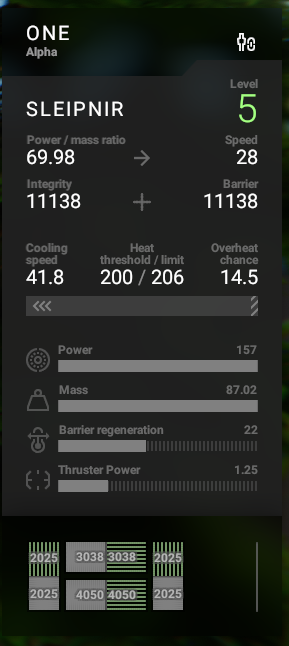

The sliding gray menus of Phantom Brigade, on the other hand, are bland and indistinct. The busy interface of a game like Highfleet appears even more inscrutable than Phantom Brigade, but it funnels its droves of information into a gorgeously intricate cockpit UI. I’d be able to forgive these UI foibles if they contributed to a cohesive thematic style. Beyond the handful of hit-and-run missions, there’s little reason for you to move away from a strategy that works, particularly when all the equipment is such a chore to parse.

The drip feed of new equipment can be slow, too, never quite nudging you to experiment with new loadouts because none of the encounters tell you beforehand what kind of weaponry you’ll encounter. Though you have the god-like ability to see five seconds into the future, that knowledge can only take you so far the rest is, in a sense, up to the pilots and all the simulated systems at work. The game operates on a bit of a hands-off quality, where you can plan and tweak and tinker, yet ultimately have to wait and see. The abject chaos of Phantom Brigade is what makes it special, what captures the whole appeal of giant robots in the first place, by giving such a sense of weight and tactility to your units even from a zoomed-out, omniscient perspective. It requires a degree of surrender to these enormous machines, an acceptance that they can’t be smoothly bent to your will. Each projectile flies individually toward its target, so while some will hit their mark, scrubbing through the replay will show others miss, or collide the environment or another mech altogether. You can try placing your mech at angles that only allow for one enemy limb to absorb a blow, but even then - the outcomes are unpredictable. When you take aim at an enemy mech, you aren’t told which part you’re going to hit or how much damage you’re going to expel. In Phantom Brigade, you have to deal with the messy uncertainty of war at every turn. But that game took place in an elegant, computerized environment, where you knew exactly what the outcome of your actions would be. In playing Phantom Brigade, I’m reminded of 2011’s Frozen Synapse, which featured a similar hybrid of real-time and turn-based mechanics. They’re constant visual payoffs to your painstaking choreography. It resembles the recap systems upon death or victory in other games like Ape Out or Super Meat Boy, which contextualize your actions in retrospect by showing them from a bird’s eye view, except in Phantom Brigade, the recaps are happening on every turn. But that same mech could get in a few final hits before the fight ends.Īnd whatever you end up doing, you can watch it over again during the next planning phase, replaying the previous five-second interval to study the details, pausing and rewinding to scrutinize the wheels you put briefly into motion. You can also leave a mech within an inch of total destruction to ensure better salvage. Or, if the distance is short enough, you might send that sturdy ally on a direct collision course with the enemy shooter, the better to bash their chassis with the swing of a shield. In response, you may send another, sturdier squadmate into the line of fire, brandishing a shield at the very last moment to deflect the shot. You may, for instance, see an enemy mech’s laser sight settle on your vulnerable sniper. Phantom Brigade offers constant visual payoffs to your painstaking choreographyīecause at any one moment, there is a lot going on. What they don’t have is the predictive technology that gives you the edge, depicting their future actions on the map.

As you trawl around the overworld map in your mobile base, looking for enemy patrols, convoys, and bases to hit, you find that the opposition always has more weapons and more pilots than you do. Your team is small, a guerrilla strike force in the midst of an invasion by some nameless enemy country.
#Phantom brigade console commands series#
Phantom Brigade, from Brace Yourself Games, is a series of intense five-second windows that, while not always intuitive, rarely fail to captivate. Then, periodically, while a rocket or a laser hangs in midair, time stops again for you to issue the next round of orders. The crucial difference is that when you click the “execute” button, the game then switches to real-time, and every action happens all at once - not only does your team move simultaneously, but so does the enemy.įor five seconds, the battlefield is utter chaos, an entrancing flurry of projectiles and explosions and crumbling buildings caught in the metallic carnage. The giant robot pilots wait patiently and indefinitely for you to queue up their commands on a five-second timeline, the ghostly image of their future moves plotted on the map for reference.

Like any other turn-based strategy game, time stands still in Phantom Brigade while you issue orders.


 0 kommentar(er)
0 kommentar(er)
